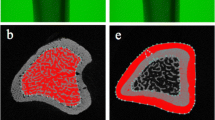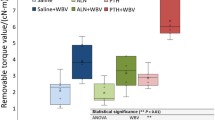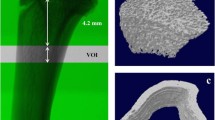Abstract
Summary
High-frequency loading via whole body vibration promotes bone formation and increases bone strength. Whether this translates to positive titanium implant osseointegration in osteoporotic bone was explored in this animal study. An anabolic effect of not only bisphosphonate treatment but also high-frequency loading on implant osseointegration in osteoporotic bone was observed.
Introduction
The present study investigated the impact of high-frequency (HF) loading, applied via whole body vibration (WBV), on titanium implant osseointegration in healthy versus ovariectomy-induced compromised versus pharmacologically treated compromised bone.
Methods
A custom-made Ti implant was inserted into the metaphyseal tibia of 59 rats and left to heal for either 4 or 14 days. Rats were divided into six groups according to their hormonal and mechanical status. WBV, consisting of 10 consecutive frequency steps at an acceleration of 0.3g, was applied daily for either 4 or 14 days. Tissue samples were processed for quantitative histology at the tibial cortical and medullar level. Data were analyzed by three-way ANOVA and by post hoc pairwise comparisons.
Results
The bone healing response at the interface and surrounding titanium implants was negatively influenced by osteoporotic bone conditions, mainly at the trabecular bone level. Furthermore, the administration of bisphosphonates for preventing the ovariectomy-induced impaired peri-implant response was successful. Finally, the effect of HF WBV loading on the peri-implant bone healing was dependent on the bone condition and was anabolic solely in untreated osteoporotic trabecular bone when applied for an extended period of time.
Conclusions
The bone healing response to implant installation is compromised in osteoporotic bone conditions, in particular at the trabecular bone compartment. Meanwhile, not only pharmacological treatment but also mechanical loading via HF WBV can exert a positive effect on implant osseointegration in this specific bone micro-environment. The peri-implant cortical bone, however, seems to be less sensitive to HF WBV loading influences.




Similar content being viewed by others
References
Feine JS et al (2002) The McGill consensus statement on overdentures. Mandibular two-implant overdentures as first choice standard of care for edentulous patients. Gerodontology 19(1):3–4
Alsaadi G et al (2008) Impact of local and systemic factors on the incidence of late oral implant loss. Clin Oral Implants Res 19(7):670–676
Rachner TD, Khosla S, Hofbauer LC (2011) Osteoporosis: now and the future. Lancet 377(9773):1276–1287
Ozawa S et al (2002) Ovariectomy hinders the early stage of bone-implant integration: histomorphometric, biomechanical, and molecular analyses. Bone 30(1):137–143
Mellado-Valero A et al (2010) Implant treatment in patients with osteoporosis. Med Oral Patol Oral Cir Bucal 15(1):e52–e57
Alghamdi HS, Jansen JA (2013) Bone regeneration associated with nontherapeutic and therapeutic surface coatings for dental implants in osteoporosis. Tissue Eng B Rev 19(3):233–253
Nijenhuis T et al (2008) Bone resorption inhibitor alendronate normalizes the reduced bone thickness of TRPV5(−/−) mice. J Bone Miner Res 23(11):1815–1824
Ruggiero SL et al (2004) Osteonecrosis of the jaws associated with the use of bisphosphonates: a review of 63 cases. J Oral Maxillofac Surg 62(5):527–534
Wang HL, Weber D, McCauley LK (2007) Effect of long-term oral bisphosphonates on implant wound healing: literature review and a case report. J Periodontol 78(3):584–594
Judex S, Gupta S, Rubin C (2009) Regulation of mechanical signals in bone. Orthod Craniofacial Res 12(2):94–104
Ozcivici E et al (2010) Mechanical signals as anabolic agents in bone. Nat Rev Rheumatol 6(1):50–59
Duyck J et al (2007) Effect of intermittent loading and surface roughness on peri-implant bone formation in a bone chamber model. J Clin Periodontol 34(11):998–1006
Duyck J et al (2006) The influence of micro-motion on the tissue differentiation around immediately loaded cylindrical turned titanium implants. Arch Oral Biol 51(1):1–9
Vandamme K et al (2007) The effect of micro-motion on the tissue response around immediately loaded roughened titanium implants in the rabbit. Eur J Oral Sci 115(1):21–29
Vandamme K et al (2008) Effect of implant surface roughness and loading on peri-implant bone formation. J Periodontol 79(1):150–157
Goodship AE, Lawes TJ, Rubin CT (2009) Low-magnitude high-frequency mechanical signals accelerate and augment endochondral bone repair: preliminary evidence of efficacy. J Orthop Res 27(7):922–930
Hwang SJ et al (2009) Extremely small-magnitude accelerations enhance bone regeneration: a preliminary study. Clin Orthop Relat Res 467(4):1083–1091
Judex S et al (2007) Low-magnitude mechanical signals that stimulate bone formation in the ovariectomized rat are dependent on the applied frequency but not on the strain magnitude. J Biomech 40(6):1333–1339
Gilsanz V et al (2006) Low-level, high-frequency mechanical signals enhance musculoskeletal development of young women with low BMD. J Bone Miner Res 21(9):1464–1474
Rubin C et al (2004) Prevention of postmenopausal bone loss by a low-magnitude, high-frequency mechanical stimuli: a clinical trial assessing compliance, efficacy, and safety. J Bone Miner Res 19(3):343–351
Christiansen BA, Kotiya AA, Silva MJ (2009) Constrained tibial vibration does not produce an anabolic bone response in adult mice. Bone 45(4):750–759
De Souza RL et al (2005) Non-invasive axial loading of mouse tibiae increases cortical bone formation and modifies trabecular organization: a new model to study cortical and cancellous compartments in a single loaded element. Bone 37(6):810–818
Akca K et al (2007) Micro-morphologic changes around biophysically-stimulated titanium implants in ovariectomized rats. Head Face Med 3:28
Ogawa T et al (2011) Influence of whole-body vibration time on peri-implant bone healing: a histomorphometrical animal study. J Clin Periodontol 38(2):180–185
Hatori K, Camargos GV, Chatterjee M, Faot F, Sasaki K, Duyck J, Vandamme K (2014) Single and combined effect of high-frequency loading and bisphosphonate treatment on the bone micro-architecture of ovariectomized rats. Osteoporosis Int. In press
Esposito M et al (2009) Interventions for replacing missing teeth: horizontal and vertical bone augmentation techniques for dental implant treatment. Cochrane Database Syst Rev 4:CD003607
Mori H et al (1997) Osseointegration of dental implants in rabbit bone with low mineral density. J Oral Maxillofac Surg 55(4):351–361, discussion 362
Dao TT, Anderson JD, Zarb GA (1993) Is osteoporosis a risk factor for osseointegration of dental implants? Int J Oral Maxillofac Implants 8(2):137–144
Steiger P et al (1992) Age-related decrements in bone mineral density in women over 65. J Bone Miner Res 7(6):625–632
Friberg B et al (2001) Branemark implants and osteoporosis: a clinical exploratory study. Clin Implant Dent Relat Res 3(1):50–56
Minsk L, Polson AM (1998) Dental implant outcomes in postmenopausal women undergoing hormone replacement. Compend Contin Educ Dent 19(9):859–862, 864; quiz 866
August M et al (2001) Influence of estrogen status on endosseous implant osseointegration. J Oral Maxillofac Surg 59(11):1285–1289, discussion 1290–1
Baron R, Tross R, Vignery A (1984) Evidence of sequential remodeling in rat trabecular bone: morphology, dynamic histomorphometry, and changes during skeletal maturation. Anat Rec 208(1):137–145
Botticelli D et al (2005) Bone regeneration at implants with turned or rough surfaces in self-contained defects. An experimental study in the dog. J Clin Periodontol 32(5):448–455
Pazzaglia UE (1996) Periosteal and endosteal reaction to reaming and nailing: the possible role of revascularization on the endosteal anchorage of cementless stems. Biomaterials 17(10):1009–1014
Szulc P et al (2006) Bone fragility: failure of periosteal apposition to compensate for increased endocortical resorption in postmenopausal women. J Bone Miner Res 21(12):1856–1863
Seeman E (2003) Periosteal bone formation—a neglected determinant of bone strength. N Engl J Med 349(4):320–323
Viera-Negron YE et al (2008) Effect of ovariectomy and alendronate on implant osseointegration in rat maxillary bone. J Oral Implantol 34(2):76–82
Chen BL et al (2011) Comparison of the effects of alendronate sodium and calcitonin on bone-prosthesis osseointegration in osteoporotic rats. Osteoporos Int 22(1):265–270
Duarte PM et al (2005) Alendronate therapy may be effective in the prevention of bone loss around titanium implants inserted in estrogen-deficient rats. J Periodontol 76(1):107–114
Hughes DE et al (1995) Bisphosphonates promote apoptosis in murine osteoclasts in vitro and in vivo. J Bone Miner Res 10(10):1478–1487
Shi HF et al (2010) Low-magnitude high-frequency vibration treatment augments fracture healing in ovariectomy-induced osteoporotic bone. Bone 46(5):1299–1305
Rubin C et al (2002) Mechanical strain, induced noninvasively in the high-frequency domain, is anabolic to cancellous bone, but not cortical bone. Bone 30(3):445–452
Chen B et al (2012) Low-magnitude high-frequency loading via whole body vibration enhances bone-implant osseointegration in ovariectomized rats. J Orthop Res 30(5):733–739
Westerlind KC et al (1997) Estrogen regulates the rate of bone turnover but bone balance in ovariectomized rats is modulated by prevailing mechanical strain. Proc Natl Acad Sci U S A 94(8):4199–4204
Judex S, Donahue LR, Rubin C (2002) Genetic predisposition to low bone mass is paralleled by an enhanced sensitivity to signals anabolic to the skeleton. FASEB J 16(10):1280–1282
Coughlin TR, Niebur GL (2012) Fluid shear stress in trabecular bone marrow due to low-magnitude high-frequency vibration. J Biomech 45(13):2222–2229
Rubinacci A et al (2008) Ovariectomy sensitizes rat cortical bone to whole-body vibration. Calcif Tissue Int 82(4):316–326
Pilliar RM et al (1979) Bone ingrowth and stress shielding with a porous surface coated fracture fixation plate. J Biomed Mater Res 13(5):799–810
Chang PC, Lang NP, Giannobile WV (2010) Evaluation of functional dynamics during osseointegration and regeneration associated with oral implants. Clin Oral Implants Res 21(1):1–12
Acknowledgments
This study was funded by the Fund for Scientific Research—Flanders (FWO) (G.0726.09).
Conflicts of interest
None.
Author information
Authors and Affiliations
Corresponding author
Rights and permissions
About this article
Cite this article
Chatterjee, M., Hatori, K., Duyck, J. et al. High-frequency loading positively impacts titanium implant osseointegration in impaired bone. Osteoporos Int 26, 281–290 (2015). https://doi.org/10.1007/s00198-014-2824-0
Received:
Accepted:
Published:
Issue Date:
DOI: https://doi.org/10.1007/s00198-014-2824-0




